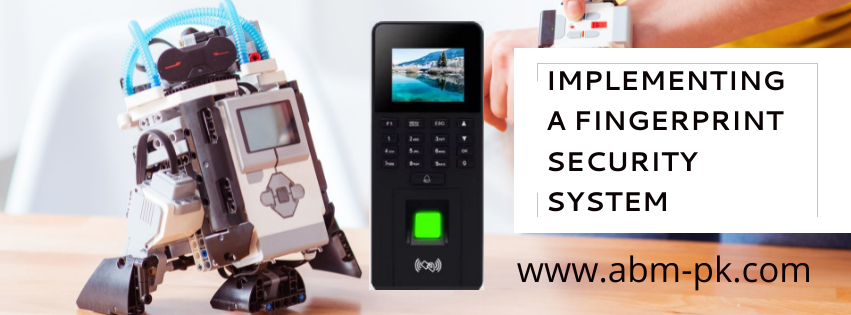Guide to Implementing a Fingerprint Security System
Think about those spy movies where a quick touch grants access to top-secret lairs. Well, implementing a fingerprint security system brings that level of sophistication to everyday security needs. It’s not just for government agencies anymore; businesses and even individuals are realizing the immense benefits of implementing a fingerprint security system.
1. Saying Goodbye to Keys and Passwords
Tired of fumbling for keys or struggling to remember yet another complex password. Implementing a fingerprint security system eliminates these hassles. Your fingerprint is unique – it’s your personal, unforgeable key. Implementing a fingerprint security system means instant, secure access with just a touch. Imagine the time saved and the frustration avoided by implementing a fingerprint security system.
2. Boosting Security Levels Significantly
Compared to traditional methods, implementing a fingerprint security system offers a significant leap in security. Keys can be lost or stolen, and passwords can be cracked. However, replicating a fingerprint is incredibly difficult, making implementing a fingerprint security system a highly secure option. Each fingerprint is unique, ensuring that only authorized individuals can gain access when you’re implementing a fingerprint security system. This makes implementing a fingerprint security system a powerful deterrent against unauthorized entry.
3. Enhancing Accountability and Tracking
Implementing a fingerprint security system allows for precise tracking of who accessed what and when. Every scan is logged, providing an audit trail that can be invaluable for security and management purposes when implementing a fingerprint security system. This level of accountability is a significant advantage of implementing a fingerprint security system, especially in sensitive areas. Knowing exactly who accessed a location or system through the fingerprint security system adds a layer of transparency and control.

4. Streamlining Access Management
Managing access permissions becomes much simpler when implementing a fingerprint security system. Adding or revoking access for individuals is a straightforward process within the system’s software. No more changing locks or issuing new keys; implementing a fingerprint security system offers centralized control. This ease of management saves time and resources when implementing a fingerprint security system across an organization.
5. Real-World Applications of Implementing a Fingerprint Security System
You see implementing a fingerprint security system in various aspects of life. Think about unlocking your smartphone with your fingerprint – that’s a basic form of implementing a fingerprint security system. Many businesses use fingerprint scanners for employee attendance, ensuring accurate timekeeping through the implementation of a fingerprint security system. High-security facilities rely heavily on implementing a fingerprint security system for controlling access to sensitive areas. Even home security systems are incorporating fingerprint technology for enhanced protection, showcasing the versatility of implementing a fingerprint security system.
6. Addressing Potential Concerns about Implementing a Fingerprint Security System
Of course, when considering implementing a fingerprint security system, some concerns might arise. Data privacy is a key consideration. Reputable fingerprint security system providers use advanced encryption and security measures to protect the stored fingerprint data. Another concern might be the accuracy and reliability of the scanners. Modern fingerprint security system technology has significantly improved, offering high accuracy and minimizing false rejections or acceptances. Implementing a well-designed and maintained fingerprint security system mitigates these risks effectively.
7. The Future of Implementing Fingerprint Security Systems
The ABM innovative FZE technology behind implementing biometric face & fingerprint security systems continues to evolve perfectly as per HR needs. We’re seeing more sophisticated algorithms and more compact, versatile scanners. Integration with other security systems and even biometric modalities is becoming increasingly common in the realm of implementing fingerprint security systems. Implementing a fingerprint security system is not just a trend; it’s a fundamental shift towards more secure and convenient access control.
Essential Steps for Implementing a Fingerprint Security System
Implementing a fingerprint security system is one of the smartest moves you can make to boost security, streamline access, and eliminate the headaches of managing passwords or keycards.
Let’s break down the process into actionable steps, peppered with real-life examples and expert insights, to help you confidently roll out a fingerprint security system that’s robust, reliable, and ready for the future.
Understand Why Implementing a Fingerprint Security System Is a Game-Changer
Implementing a fingerprint security system means ditching passwords, PIN codes, and physical keys for a solution that’s fast, secure, and user-friendly. Commonly finger prints lines are unique to each human individual, making unauthorized access nearly impossible. From unlocking smartphones to securing corporate offices and even tracking attendance in large organizations, fingerprint security systems are everywhere.
For example, American Airlines uses biometrics to speed up boarding at airports, while banks and schools rely on fingerprint systems to prevent identity theft and ensure only authorized personnel gain access control system Dubai.
Choose the Right Hardware for Your Fingerprint Security System
Selecting the right fingerprint scanner is crucial. Options range from simple USB-based devices for computers to advanced modules that integrate with microcontrollers like Arduino.
A typical setup includes, A fingerprint sensor module (capacitive or optical, A central controller (like an Arduino board, Visual or audio indicators LEDs or buzzers, Optional: LCD displays or keypads for user interaction, Make sure your hardware is reliable and can handle environmental changes like temperature and humidity, which can affect sensor performance.
Set Up the Software and Enroll Users
Implementing a fingerprint security system isn’t just about hardware. You’ll need to install the right libraries and software to capture, store, and compare fingerprint data. The enrollment process involves taking multiple scans of each user’s finger to ensure accuracy. This data is securely stored—often encrypted—so even if someone gains access to the system, they can’t easily exploit the information.
Integrate the Fingerprint Security System with Access Control
Connect your fingerprint security system to whatever you want to secure—doors, computers, or even time clocks. When a user scans their finger, the system compares it to the stored templates.
If there’s a match, access is granted, and an LED lights up or a buzzer sounds. If not, access is denied, and you can even program the system to alert the owner or record unauthorized attempts.
Prioritize Security and Privacy from Day One
Implementing a fingerprint security system means handling sensitive biometric data. Always store fingerprint templates as encrypted values, not raw images, to prevent misuse if the system is compromised. Modern systems use privacy-by-design principles, sometimes leveraging distributed ledgers or blockchain to further protect personal data.
Test, Troubleshoot, and Upgrade
No fingerprint security system is perfect out of the box. Test the system with multiple users, different lighting conditions, and varying finger conditions (wet, dry, etc.). Continuously monitor performance and update the software to patch vulnerabilities or add new features like anti-spoofing or multi-factor authentication. Many organizations, from hospitals to government agencies, have saved money and improved efficiency by regularly refining their fingerprint security systems.
Scale and Future-Proof Your Fingerprint Security System
As your needs grow, your fingerprint security system should scale too. Modern systems can handle thousands—even millions—of users, making them ideal for everything from small offices to national ID programs. Keep an eye on emerging trends like 3D fingerprint imaging and AI-driven matching algorithms to stay ahead of security threats and ensure your system remains state-of-the-art.
Why Implementing a Fingerprint Security System Is Worth It
Convenience no more forgotten passwords or lost keys—just a quick scan and you’re in. Speed: Authentication takes seconds, keeping lines moving and users happy. Security: Fingerprints are nearly impossible to replicate, and encrypted storage keeps data safe. Real-World Impact: From tracking employee attendance to securing government facilities, fingerprint security systems are proven performers. Implementing a fingerprint security system isn’t just a tech upgrade—it’s a strategic move that pays off in security, efficiency, and peace of mind.
Start with the right hardware, prioritize privacy, and keep improving, and you’ll have a system that stands strong against today’s threats and tomorrow’s challenges.

Frequently Asked Questions about Implementing a Fingerprint Security System
Q: Is implementing a fingerprint security system expensive?
A: The cost of implementing a fingerprint security system can vary depending on the scale and complexity of the system. However, with advancements in technology, the cost has become more accessible for various applications of implementing a fingerprint security system.
Q: How secure is implementing a fingerprint security system?
A: Implementing a fingerprint security system offers a high level of security due to the unique nature of fingerprints and the sophisticated technology used in fingerprint scanners and data encryption.
Q: What happens if the fingerprint scanner doesn’t recognize my fingerprint when implementing a fingerprint security system?
A: Most fingerprint security systems have backup methods, such as PIN codes or access cards, in case the fingerprint scanner fails to recognize a fingerprint during the implementation of a fingerprint security system.
Q: Can fingerprints be easily copied to bypass a fingerprint security system?
A: Modern fingerprint security system technology includes measures to prevent spoofing, such as liveness detection, making it very difficult to bypass the system by copying fingerprints when implementing a fingerprint security system.
Q: Is the data stored by a fingerprint security system secure?
A: Reputable vendors of fingerprint security systems employ robust encryption and security protocols to protect the stored fingerprint data, ensuring the privacy and security of the information gathered when implementing a fingerprint security system.

Conclusion
Implementing a fingerprint security system offers a powerful blend of security, convenience, and accountability. As technology advances, implementing a fingerprint security system will likely become even more prevalent in our daily lives.


Pingback: Cost of face attendance machine
Pingback: Smart Lock and Attendance App
Pingback: Door access control system for office
Pingback: Multi Modal Biometric AI Authentication
Pingback: Rise of access control installation
Pingback: Fingerprint V/S AI Face Recognition
Pingback: Garrett Handheld V/S Guard Tour Scanner